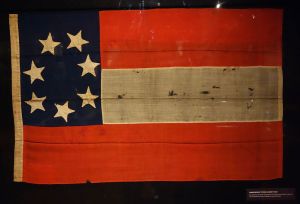
First National Flag (“The Stars and Bars”)
First National Flag (“The Stars and Bars”)
- Flown from March 4, 1861 to May 1, 1863
- March 4, 1861 to May 21, 1861: Flag had 7 stars
- May 21, 1861 to June 2, 1861: Flag had 9 stars
- July 2, 1861 to November 28, 1861: Flag had 11 stars
- November 28, 1861 to May 1, 1863: Flag had 13 stars
- Designed by Prussian artist Nicola Marschall
- Many people criticized the flag for being too similar to the U.S.A.’s flag.
- They added the last two stars to reflect Kentucky and Missouri, even though they were never officially admitted into the Confederacy.
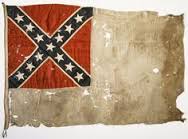
Second National Flag (“The Stainless Banner”)
Second National Flag (“The Stainless Banner”)
- Flown from May 1, 1863 to March 4, 1865
- It was called “the White Man’s Flag” by the editor of the Savannah Morning News, who said, “As a people we are fighting to maintain the Heaven-ordained supremacy of the white man over the inferior or colored race; a white flag would thus be emblematical of our cause.”
- It was initially received well, but then criticized because it could be mistaken for a white flag of truce if there was no wind.
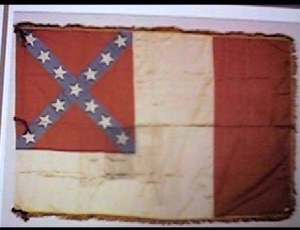
Third National Flag (“The Blood-Stained Banner”)
Third National Flag (“The Blood-Stained Banner”)
- Flown from March 4, 1865 to the fall of the Confederacy
- The red bar was added to prevent the flag from looking like a white flag of truce.
- Very few of these flags were actually manufactured.
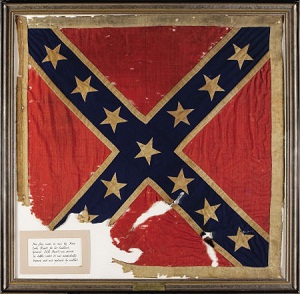
Confederate Battle Flag (Army of Northern Virginia)
Confederate Battle Flag (Army of Northern Virginia)
- This flag was widely popular, and was incorporated into the next design of the Confederate national flag.
- This flag was SQUARE—not rectangular! It was different sizes for different branches of service (52 inches for infantry, 38 inches for artillery, and 32 inches for cavalry).
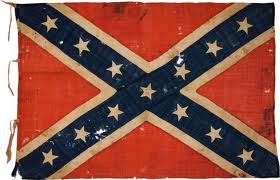
Confederate Battle Flag (Army of Tennessee)
Confederate Battle Flag (Army of Tennessee)
- This flag is commonly referred to as the Confederate flag, but it was in fact just the battle flag for the Army of Tennessee. It is a rectangular version of the first square battle flag for the Army of Northern Virginia.
- It was designed by William Porcher Miles (head of the Flag and Seal committee) and proposed as the national flag, but it was rejected in favor of the “Stars and Bars” design. This flag is sometimes incorrectly referred to as “Stars and Bars.”